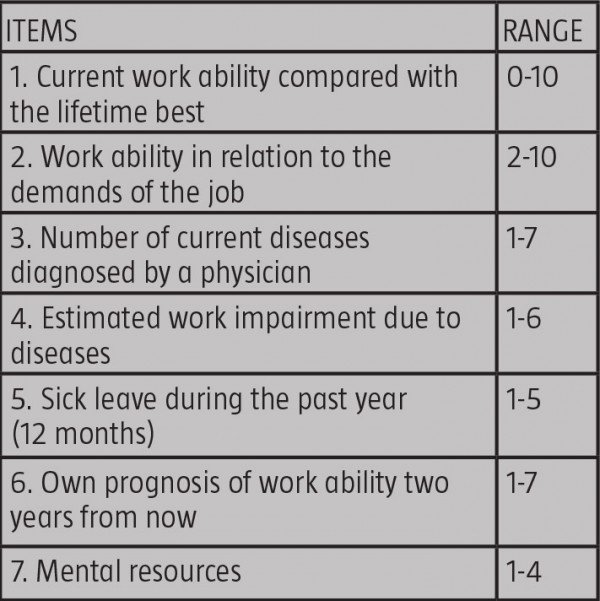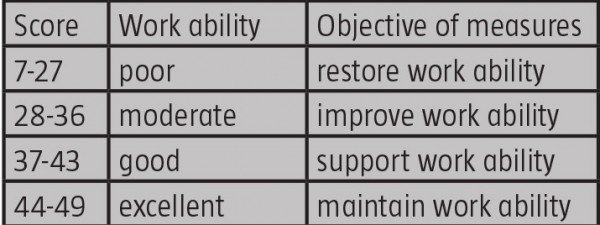
Developed by the Finnish Institute of Occupational Health, the work ability index is an innovative tool that can help employers promote employee health over their working lives. Jorma Seitsamo explains how it works.
The work ability index (WAI) is used in occupational health care and research to assess an employee’s work ability during health examinations and workplace surveys. It reveals how well an employee is able to perform his or her work.
The index is determined on the basis of the answers to a series of questions, which take into consideration the individual’s work demands, the worker’s health status and resources. The employee completes the questionnaire before the interview with an occupational health professional and they rate the responses according to the instructions given. WAI is a summary measure of seven statements (range 7–49).
The work ability index (WAI) statements are shown below:
 The WAI score depicts the employee’s perception of his/her own level of work ability. The objectives of any measures deemed necessary are classified as follows:
The WAI score depicts the employee’s perception of his/her own level of work ability. The objectives of any measures deemed necessary are classified as follows:
 Occupational health care personnel can use the index in their overall assessment of an employee’s work ability and functional capacity. They consider whether, in addition to the work ability index, other evaluations, such as tests measuring physical or mental function or laboratory tests, are needed.
Occupational health care personnel can use the index in their overall assessment of an employee’s work ability and functional capacity. They consider whether, in addition to the work ability index, other evaluations, such as tests measuring physical or mental function or laboratory tests, are needed.
Once a reliable assessment of an employee’s work ability has been made, the occupational health personnel can determine the measures and recommendations needed to support it and then develop the individual’s job, their work conditions and work environment (employee’s feed-back form and follow-up form for actions taken). The need for supportive measures depends on the individual’s work ability and functional capacity and on his or her work conditions.
If their work ability is excellent, the occupational health personnel should explain which work and lifestyle factors may help maintain and which may weaken his or her work ability. The worker is urged to continue to avoid or decrease the factors, which weaken work ability.
Attempts to strengthen a good work ability are supported, and it is determined whether the individual’s work and lifestyle have features to help strengthen work ability or whether they have characteristics that threaten it.
If their work ability is moderate, an effort should be made to increase the worker’s own initiatives to promote his or her work ability (diet, exercise, sleep and rest, social activities). In addition, a worker may need rehabilitation.
Often a worker also needs the means to develop his or her professional knowledge and to increase and diversify his or her occupational skill. What’s more, any risks in the work or work environment and wider organisation and problems with supervisors should be corrected.
If their work ability is poor, the prerequisites and possibilities for rehabilitation should be determined. Employers should also consider whether the employee’s work ability could be restored by correcting the hazards found in his or her work or work environment and by remodelling the work environment to make it more efficient. Potential solutions could be job rotation, changing tasks, free work shifts and other individual interventions.
The index can also be used to predict the threat of disability in the near future. The Finnish Institute of Occupational Health developed the tool in its follow-up study of ageing municipal workers, and it was found to predict the incidence of work disability for a group of 50-year-olds.
The validity and reliability of the WAI has been assessed with clinical examinations and correlation analyses. The WAI and all its items reliably predicted work disability, retirement and mortality.
Jorma Sietsamo is a researcher at the Finnish Institute of Occupational Health
References
* Tuomi, K., et al., Work Ability Index. 1998, Finnish Institute of Occupational Health: Helsinki.
* Ruoppila, I, et al., Age-Related Changes of the Work Ability Construct and its Relation to Cognitive Functioning in the Older Worker. Jyvaskyla studies in Education, Psychology and Social Research, 336, Jyvaskyla 2008.
What makes us susceptible to burnout?
In this episode of the Safety & Health Podcast, ‘Burnout, stress and being human’, Heather Beach is joined by Stacy Thomson to discuss burnout, perfectionism and how to deal with burnout as an individual, as management and as an organisation.
We provide an insight on how to tackle burnout and why mental health is such a taboo subject, particularly in the workplace.





Working with an ageing workforce in high risk roles, this is very interesting if it can provide business with some accurate measures/predictors – Is it’s use widespread in Finland elsewhere in Europe? Are OH professionals in Finland provided with specific training in it’s use/application? Also would be useful if Jorma could provide a weblink/reference to access the most up to date version of the tool. Have any OH professionals in the UK experience in using this tool as a predictor ?Thanks.